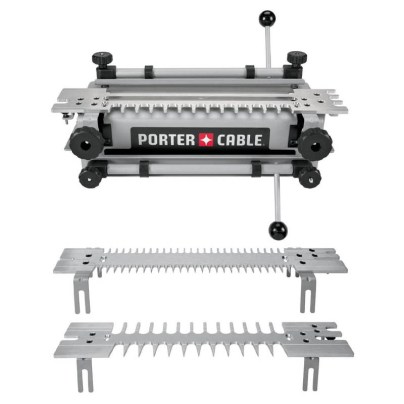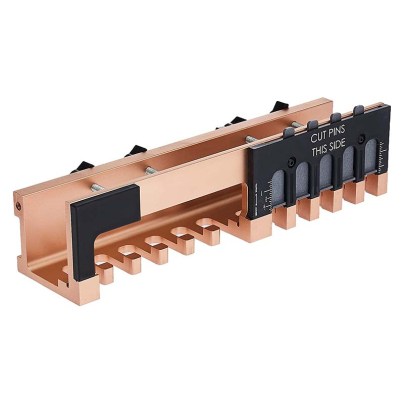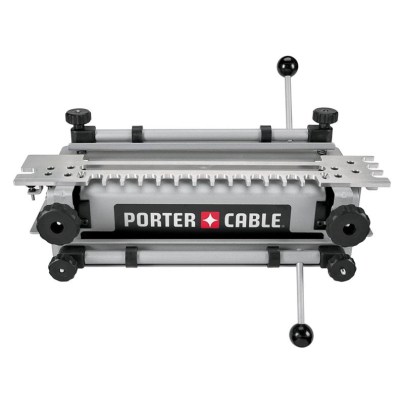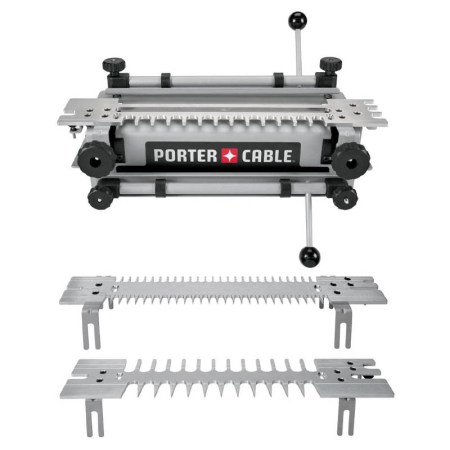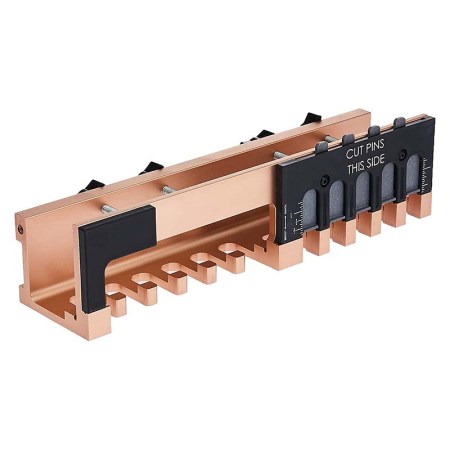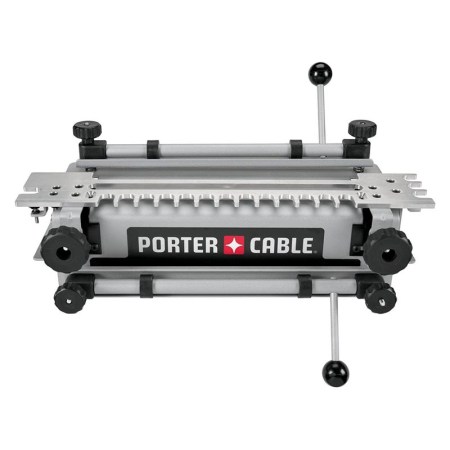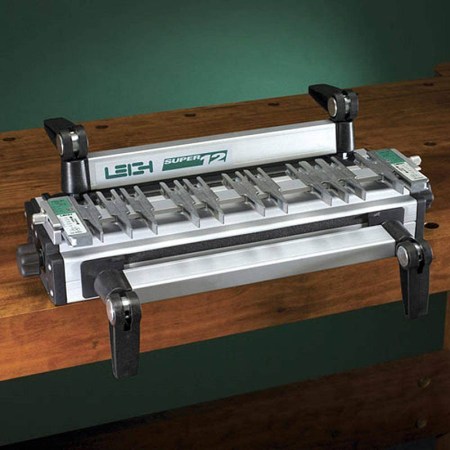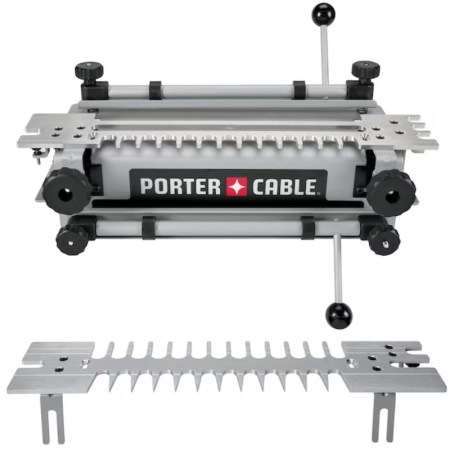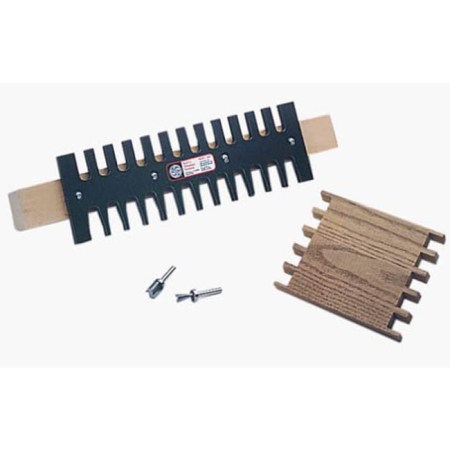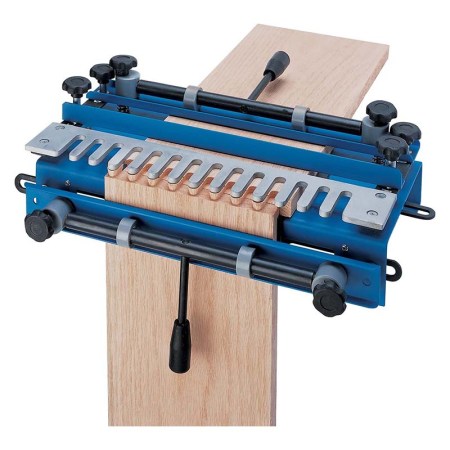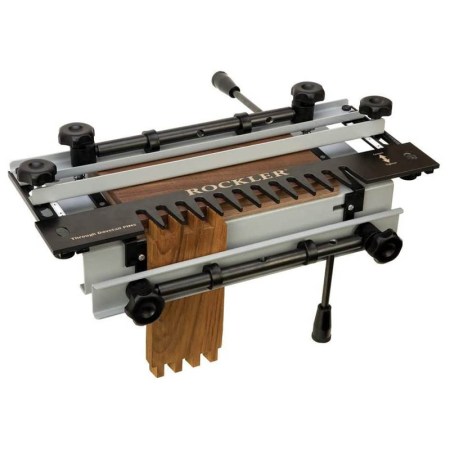We may earn revenue from the products available on this page and participate in affiliate programs. Learn More ›
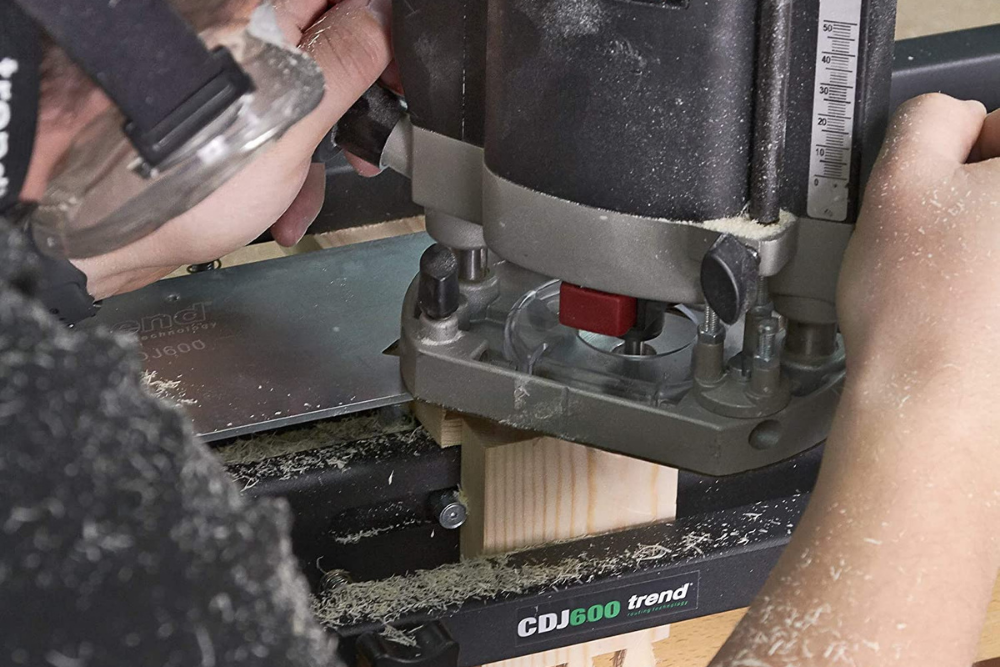
For DIYers looking to increase their craftsmanship during woodworking projects, dovetail jigs could be the answer. These jigs allow users to create strong and accurate dovetail joints for boxes, drawers, and furniture without fasteners. In fact, some craftspeople consider a dovetail jig an essential tool for any woodworking shop.
The best dovetail jigs clamp workpieces in place, allowing users to run a router along a template. This creates an interweaving joint that looks like a series of bird’s tails, just as the name implies. A wood dovetail joint is a very strong, stable joint with plenty of surface for gluing. This guide will help shoppers choose the best dovetail jig for any workshop.
- BEST OVERALL: Porter-Cable 4216 12-Inch Dovetail Jig Kit
- BEST BANG FOR THE BUCK: General Tools E-Z Pro Dovetail Jig
- UPGRADE PICK: Porter-Cable 4210 12-Inch Dovetail Jig
- BEST FOR HALF-BLINDS: Leigh Super12 12-Inch Dovetail Jig
- BEST FOR LARGE PROJECTS: Porter-Cable 4212 12-Inch Dovetail Jig
- BEST FOR SMALL WORKSHOPS: Keller 1500 Journeyman Dovetail Jig
- BEST FOR BEGINNERS: Woodstock D2796 Dovetail Jig With Aluminum Template
- BEST FOR DUST: Rockler Complete Dovetail Jig
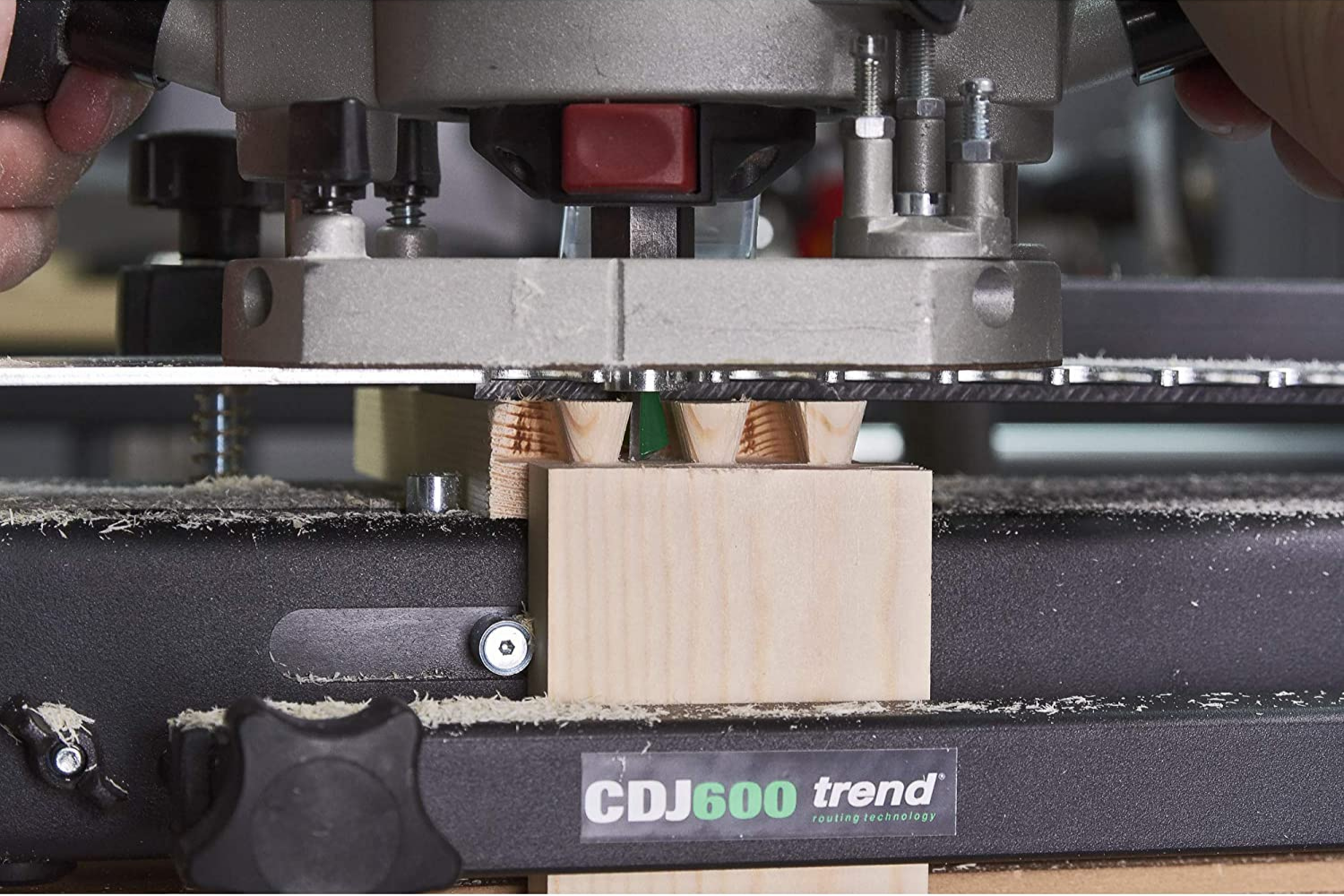
How We Chose the Best Dovetail Jigs
Dovetail jigs are something of a staple in old-school woodworking shops, so putting a list together of the top models was no small feat. We had to draw upon our experiences in woodworking and DIY projects to consider the features and capacities we find most helpful just to get started.
With a list of the most important features down, we performed extensive product research to find dovetail machines that we felt might meet our needs. We then compared those products’ quality features, additional items, capacities, and prices to ensure they offered enough value. We tossed out the dovetail jigs that couldn’t cut it, and then gave the models that made it awards based on their strengths.
Our Top Picks
Read on to find a list of some of the top jigs for woodworking projects. Some products have plenty of templates and guides, but others take a more minimal approach to joinery. Check into these products to help find the best dovetail jig for a variety of needs.
Best Overall
Porter-Cable 4216 12-Inch Dovetail Jig Kit
See ItProduct Specs
- Capacity: 12 inches
- Fixed/variable: Fixed
- Types of joints: Half-blind, rabbeted half-blind, sliding, box joints, and through dovetails
Pros
- 1-piece construction with solid clamping to prevent slipping and increase grip while using
- Versatile construction; includes jigs for several dovetail types for precision and accuracy
- This kit accepts 2 boards at once for 1-step milling quickly
Cons
- No bits or router collars included; may be tricky for some users
For a dovetail jig combination kit that can check most of the boxes for router joinery, this one from Porter-Cable is the way to go. It comes with almost everything necessary to start cutting a variety of dovetails, save for the router and bits.
This Porter-Cable 12-inch dovetail jig features a one-piece steel base and fixed aluminum templates including half-blind, rabbeted half-blind, through, box joints, and sliding dovetails. It has a 12-inch capacity and sandpaper-backed cam-type clamps for quickly securing boards in place. Also, users will find the onboard instructions helpful when setting the Porter-Cable dovetail jig up. Note that it can handle two boards at once, making cutting dovetails a one-step process. Unfortunately, it doesn’t come with a bit or router collars—those require an upgrade to the next kit in the Porter-Cable lineup.
Get the Porter-Cable 4216 dovetail jig at Amazon, Lowe’s, or Northern Tool + Equipment.
Best Bang For The Buck
General Tools E-Z Pro Dovetail Jig
See ItProduct Specs
- Capacity: 12 inches
- Fixed/variable: Fixed
- Types of joints: Through and half-blind dovetails; box joints
Pros
- Easy repositioning thanks to the alignment tool; suitable for quick working times
- Includes jig and router bit; can be used as a dovetail jig for router table
- Screw-down clamps attach firmly to prevent vibration and slipping while in use
Cons
- No additional templates included; may not provide the results desired
For an affordable approach to dovetails, check out the E-Z Pro dovetail jig from General Tools. This jig’s design allows users to attach it to the board and use it with a router table or handheld router. The design also provides the ability to mill boards of any width, and the open-ended design and alignment tool help in repositioning. The maximum width it can handle without repositioning is six inches.
This kit comes with the jig and router bit—a nice touch for such an affordable model. It also contains several screw-down clamps for clamping the jig securely onto the board. While it doesn’t have additional templates, it does offer an effective way to create box and dovetail joints on boards of any width.
Get the General Tools dovetail jig at Amazon, The Home Depot, Walmart, or TEquipment.
Upgrade Pick
Porter-Cable 4210 12-Inch Dovetail Jig
See ItProduct Specs
- Capacity: 12 inches
- Fixed/variable: Fixed plates
- Types of joints: Half-blind, rabbeted half-blind, sliding, dovetail dadoes, box joints, and miniature dovetails
Pros
- 12-inch capacity mills 2 boards at once; suitable for completing heavy-duty tasks quickly
- Solid 1-piece base with cam-like clamps for securing to a workbench
- Router bit depth gauges allow for accuracy while milling and cutting
- Comes with heavy-duty Porter-Cable 4211 CNC-machined aluminum template for longevity
Cons
- May take some time to set up ahead of first use
- Some users report difficulty while using the included onboard guide
This Porter-Cable 12-inch dovetail jig is great for anyone in need of having everything necessary to create a wide range of joints. The jig comes with a solid one-piece base and cam-like clamps that properly secure it to the workbench, allowing the creation of accurate joints in a one-step process.
The jig comes with a Porter-Cable 4211 CNC-machined aluminum template for half-blind, rabbeted half-blind, and sliding dovetails as well as dovetail dadoes, box joints, and miniature dovetails. The template alignment lines are also easy to set up for use. Plus, this model comes with router bit depth gauges for added accuracy and has on-board instructions for guidance.
Get the Porter-Cable 4210 dovetail jig at Acme Tools, Menards, or MSC Industrial.
Best for Half-Blinds
Leigh Super12 12-Inch Dovetail Jig
See ItProduct Specs
- Capacity: 12 inches
- Fixed/variable: Variable
- Types of joints: Sliding, through, and half-blind
Pros
- Comes with 3 additional router bits for convenience and versatility while dovetailing wood
- Adjustable 1-piece fingers guarantee a half dovetail pin at the edge of each joint
- Specializes in half-blind dovetail joints thanks to the blind bridge and bit
Cons
- Expensive compared to similar options available; too many bells and whistles for simple use
DIYers looking for an adjustable dovetail jig that can handle half-blind joints (as well as others) will want to give Leigh’s Super12 dovetail jig some thought. This jig can handle milling two boards at once, each up to a 12-inch capacity. The one-piece fingers are also infinitely adjustable, allowing the user to create joints of any pattern or spacing. These fingers are also easily positioned, guaranteeing half of a dovetail pin at each edge of the joint.
This jig can cut through and sliding dovetails, but it specializes in half-blind dovetails. It comes with a special half-blind bridge for guiding the router to improve accuracy, as well as a half-blind bit. The entire kit includes three bits, a router collar, and a sliding dovetail fence. Admittedly, it’s expensive, but the accuracy and adjustability it offers may be worth the expense.
Get the Leigh dovetail jig at Amazon or Woodcraft.
Best for Large Projects
Porter-Cable 4212 12-Inch Dovetail Jig
See ItProduct Specs
- Capacity: 12 inches
- Fixed/variable: Fixed
- Types of joints: Half-blind, rabbeted half-blind, sliding, through dovetails, and box joints
Pros
- Large 12-inch capacity is ideal for drawers, boxes, and furniture
- Comes with 2 fixed aluminum templates for creating a wide range of joints
- Each template has camlike clamps and sandpaper-backed locking bars for a firm grip while in use
- Preassembled single-piece steel base can be bolted or clamped to a workbench
Cons
- Some users have reported difficulty using; may take a learning curve for newcomers
DIYers or professionals can benefit from the large 12-inch capacity and overall versatility of this dovetail jig from Porter-Cable. Coming with two fixed aluminum jig templates, this model is made to create a wide range of joints, including rabbeted half-blind, half-blind, sliding, through dovetails, and box joints. This model is ideal for furniture, drawers, boxes, and more.
As for ease of use, this Porter-Cable dovetail jig has cam-type clamps with sandpaper-backed locking bars for a stable, firm grip and a bit depth gauge for accuracy without taking precise measurements. Finally, this aluminum jig has a preassembled single-piece steel base that can be bolted or clamped to a workbench if desired.
Get the Porter-Cable 4212 dovetail jig at Lowe’s.
Best for Small Workshops
Keller 1500 Journeyman Dovetail Jig
See ItProduct Specs
- Capacity: Repositionable
- Fixed/variable: Fixed
- Types of joints: Through, box, or dovetail
Pros
- Small and compact; suitable for workshop use or for transporting to the jobsite
- Versatile pick; comes with router bits for dovetails or box joints
- Unlimited capacity can take on light-, medium-, and heavy-duty projects
Cons
- Repositioning requires a careful eye to ensure accuracy; may be tricky for some users
Small workshops require compact, flexible tools like Keller’s 1500 Journeyman dovetail jig. The Journeyman is a one-piece kit that DIYers can use to cut through, dovetails, or box joints. The kit mounts to a strip of wood and measures 15 inches wide, though it’s repositionable for unlimited capacity.
This model comes with two router bits for cutting dovetails or box joints, complete with ball-bearing guides that ride along the template plate. While the capacity is limitless, repositioning this jig will require a careful eye to ensure accuracy. However, the benefit of this simple design is that it can sit on a shelf or rack until needed.
Get the Keller dovetail jig at Amazon, Walmart, or Keller.
Best for Beginners
Woodstock D2796 Dovetail Jig With Aluminum Template
See ItProduct Specs
- Capacity: Repositionable
- Fixed/variable: Fixed
- Types of joints: Half-blind dovetails
Pros
- Versatile, solid capacity of up to 12 inches wide for light- to heavy-duty jig projects
- Easy to use and set up for beginners as well as DIYers
- Comes with easily adjustable knobs to mount the tool to a tabletop
- Vertical or horizontal cam-action clamping system keeps wood in place while in use
Cons
- Router requires a 7/16-inch guide bushing to operate properly
Those who need an easy-to-use tool can rely on the D2796 dovetail jig from Woodstock. This versatile tool comes with a sturdy ½-inch aluminum dovetail template for durability, and the setup is easy for first timers.
As for capacity, this model comes with ½ to 1¼-inch stock capacity for large and small pieces of wood, and the half-blind joints can make ½-inch dovetails. With these capacities also comes the capability of fitting a piece of wood that is up to 12 inches wide.
The large, easy-adjustable knobs help for mounting to a table. Plus, the vertical or horizontal cam-action clamping system also reduces slipping and movement while using. Finally, the sturdy stamped steel construction allows for use for years to come. The only downside to this option is that the router requires a 7/16-inch guide bushing to operate.
Get the Woodstock dovetail jig at Amazon or The Home Depot.
Best For Dust
Rockler Complete Dovetail Jig
See ItProduct Specs
- Capacity: 11 inches
- Fixed/variable: Fixed
- Types of joints: Through and half-blind dovetails
Pros
- Compatible with dust-collection system to prevent dust and debris particles from circulating
- Light and compact enough to store when needed; doesn’t take up much space while stored
- Comes with 3 bits, a collar, a bushing, and 2 templates
Cons
- While it’s compatible with Rockler’s dust-collection system, this jig doesn’t come with it
Folks tired of sweeping or vacuuming their floors, work tables, and other surfaces between milling every joint will want to give this jig from Rockler a look. It’s compatible with the brand’s dust collection system, allowing users to mill boards at will while drastically reducing the mess involved.
This Rockler complete dovetail jig features one-step milling, clamping two boards in place at once. It can handle through and half-blind dovetails, and the compact and lightweight design makes it easy to store away. It comes with the jig, two fixed templates, three router bits, a collar, and a guide bushing for accurate routing. The half-blind bridge will help with accuracy, as well. The main complaint is that the dust collection system is sold separately.
Get the Rockler dovetail jig at Amazon or Rockler.
Jump to Our Top Picks
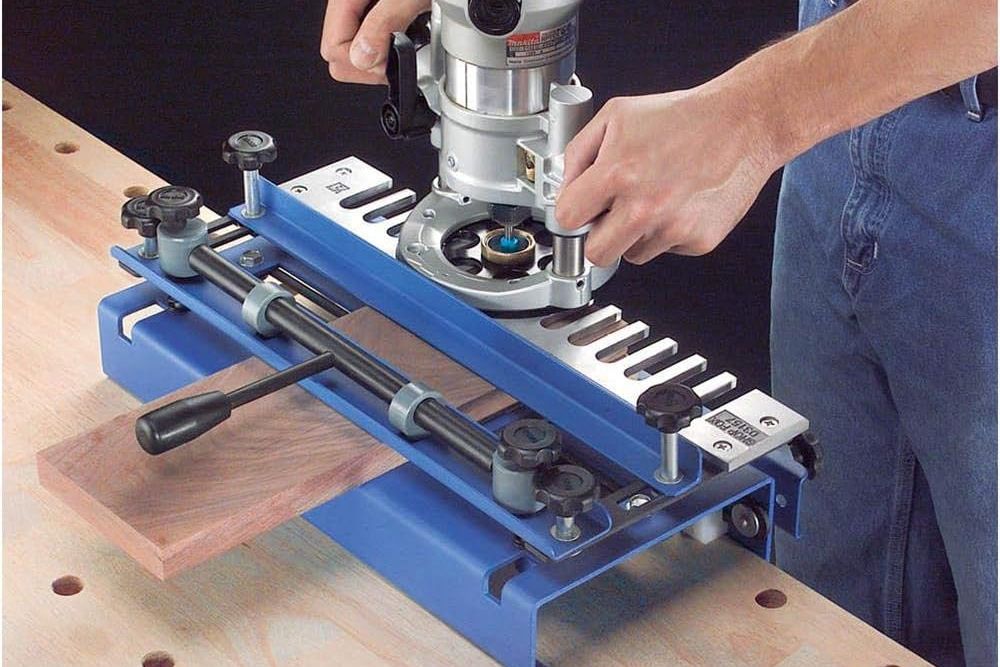
What to Consider When Choosing a Dovetail Jig
Dovetail jigs aren’t new technology, but they’re a less popular and approachable method for joinery than pocket hole jigs. That said, dovetail joints are strong and old-school, though new DIYers might not be familiar with them or know what to look for when shopping. The following sections contain some of the most important factors to consider when shopping for dovetail tools.
Material
When choosing the best dovetail jig, consider the materials used in each product’s construction. The dovetail joints of years past were usually cast iron in construction, and if they received regular maintenance, they lasted almost forever. However, they were very heavy and expensive. Today’s models use cast aluminum or steel in their construction.
Dovetail jigs with aluminum parts and templates are light and usually very accurate when making dovetail joints, but they can be expensive. Steel jigs and templates are heavier and less expensive, but they’re also less likely to bend and become inaccurate than an aluminum jig. Unlike aluminum, steel jigs also are susceptible to rust, so it’s best to store them in a dry shop.
One-Step vs. Two-Step
Two types of dovetail jigs are available. One-step jigs usually are a bit more expensive than two-step jigs, but for good reason.
A one-step jig allows users to cut the joint in two boards at the same time. By holding the board ends perpendicular to each other, users can run the router over both boards, creating an incredibly accurate joint. Two-step jigs allow users to mill only one board at a time: The board must be unclamped and replaced with the other board, which can introduce room for error.
Fixed vs. Variable Template
Depending on the level of customization needed, users might choose a fixed or variable jig. Each makes robust and reliable joints but with different degrees of customization.
Fixed template jigs use solid templates that create a perfectly uniform and consistent joint. Their guides are spaced evenly and consistently. Users can choose from fixed dovetail jigs with different spacing or shapes, but the actual templates are not adjustable.
Variable templates allow users to adjust the spacing, the number of guides, and the look of the dovetail joint. This less uniform look creates a more handmade appearance that many craftspeople appreciate.
Capacity
Before purchasing a dovetail jig, consider the size of the boards each jig can handle. Many jigs can handle boards only of a certain size before they must be removed and repositioned. The more often the boards are repositioned, the more room for error.
For cabinetmaking work, a jig with a 12-inch capacity is usually enough for most drawers. Drawers are rarely deeper than 12 inches, but if they go deeper, some jigs allow the boards to be repositioned to keep milling.
For deeper boxes and crates, many craftspeople prefer a jig with a bit more capacity, such as one within the 24-inch range. They allow the creation of large dovetailed box joints with the router.
Accuracy
When considering the best dovetail jig for projects, accuracy trumps any other factor. If the dovetail jig isn’t accurate, it will create loose, sloppy joints or worse: joints that don’t fit together at all.
While most jigs have consistent, accurate templates, the quality of the jig itself has a lot to do with the accuracy of the joint. If the jig has lower-quality fittings, clamps, or hardware, things may shift while using the jig. Shifting will create less consistent results. Many of the best options are from trusted brands that use quality parts and hardware made from steel or aluminum.
Types of Joints
As a user’s woodworking journey unfolds and they start to become a better craftsperson, they often appreciate the ability to create a different look or style of joint with a dovetail jig.
Dovetail jigs are useful and fun because they can create so many different types of joints. By swapping out a template, the user can change from making a standard dovetail to a box joint to a half-blind or even a full-blind mitered joint.
Ease of Use
A DIYer probably doesn’t have years of old-school cabinetmaking experience to rely on when setting up a dovetail jig. As a result, most people look for a jig that’s easy to set up and use. Quick-change jigs and quick-grabbing clamps help with setup. Jigs with guides also are available for setting the depth accurately, which is an essential measurement for blind and half-blind joints.
Also, consider the ease of cutting joints with the jig. Models that come with swappable router collars allow users to run the router along the guides smoothly, creating accurate joints. Quick lever-activated clamps also help make setup quicker and easier.
Lastly, consider the size and weight of the jig. If the jig is in a dedicated woodworking or cabinetmaking shop, removal and storage aren’t an issue, but most home craftspeople don’t have space to keep the jig up all the time. Older cast-iron jigs were fairly heavy, but today’s models are much more manageable. Remember: The longer the jig, the longer the board it can handle, but it’ll be more difficult to store.
Shopping for a Used or Refurbished Dovetail Jig
While there are lots of great dovetail jigs on the market to choose from, it might be worth shopping for a used model. Dovetail jigs have been around a long time, and the older models were extremely durable, meaning there are probably quite a few around, and the deals can be worth the effort.
Many older dovetail kits featured cast iron construction, making them extremely durable (though a bit heavy). While they may not be adjustable, these jigs are almost sure to be accurate as long as they’re whole (no missing or bent teeth). And older DIYers or retiring woodworkers looking to pass them onto new craftspeople may entertain steep discounts to move these heavy tools.
The downside is that these tools aren’t always readily available on sites like Amazon Renew, Ebay Refurbished, or Walmart Refurbished. Due to their weight, they can be cost-prohibitive to ship, though it may be worth checking those sites first, anyway. Local yard sales and swap meets may be a better bet.
Tips for Using a Dovetail Jig
If any play or wobble occurs in the jig or workpieces, the results won’t be as accurate. Clamp the jig base securely to the table or the workpiece to ensure the best possible joints.
If the boards come from a home improvement store, be sure to square up their ends before placing them in the router jig. Factory ends are rarely square, and routing them in a dovetail jig will create a box that wobbles or doesn’t assemble properly. Consider running them over a dovetail jointer to ensure that all of the surfaces are perfectly square. If not, a hand plane will do the trick.
Alignment is everything. When clamping the workpiece into the jig, ensure that everything is square and aligned properly. Take your time and make sure that this part of the process is correct. A mistake here can end with a poorly cut joint and two boards that don’t align properly. This step is even more critical when repositioning a jig for a wider board: A small mistake here could keep the joint from coming together at all.
- For consistent results, be sure the jig or workpiece is clamped securely to the table.
- Square the ends of the boards before milling them on the jig.
- Ensure accurate alignment, especially when repositioning the jig on a wider board.
FAQs
Now that you know a bit more about the products that are available for helping cut dovetails, other questions may arise. Here, find a collection of some of the most frequently asked questions about dovetail jigs and their answers. If you still have questions, a manufacturer’s customer representative customer service department may help.
Q. Do you need much experience to use a dovetail jig?
No, experience isn’t necessary, but it’s important to realize that small mistakes can end up in ruined joints. Taking time, aligning the workpieces, and ensuring that everything is stable on the workbench — all help achieve excellent results.
Q. What is a lapped dovetail joint?
Lapped dovetail joints are popular in cabinetmaking. These joints look like standard dovetails; however, the dovetails don’t extend all the way through one of the pieces. This makes the dovetails hidden from one side of the joint.
Q. What is a full-blind dovetail?
The dovetails in a full-blind joint are just like standard dovetails, but they don’t pass all the way through. They aren’t visible from any side of the joint. The dovetails hide inside the joint and provide a strong joint with lots of glue surface.
Q. Are any dovetail joints weaker than the rest?
Comparing strength in dovetail joints comes down to several different variables, including the size of the dovetails and even the strength of the wood. However, comparing dovetails to box joints and other lap-style joinery almost always shows that dovetails are the strongest when compared to fingerjoints and box joints.
Q. What kind of joints can you make with a dovetail jig?
The possibilities are endless, but a dovetail jig can create dovetail, hidden dovetail, through dovetail, sliding dovetail, mitered dovetail, and box joints, just to name a few.
Why Trust Bob Vila
Bob Vila has been America’s Handyman since 1979. As the host of beloved and groundbreaking TV series including “This Old House” and “Bob Vila’s Home Again,” he popularized and became synonymous with “do-it-yourself” home improvement.
Over the course of his decades-long career, Bob Vila has helped millions of people build, renovate, repair, and live better each day—a tradition that continues today with expert yet accessible home advice. The Bob Vila team distills need-to-know information into project tutorials, maintenance guides, tool 101s, and more. These home and garden experts then thoroughly research, vet, and recommend products that support homeowners, renters, DIYers, and professionals in their to-do lists.
